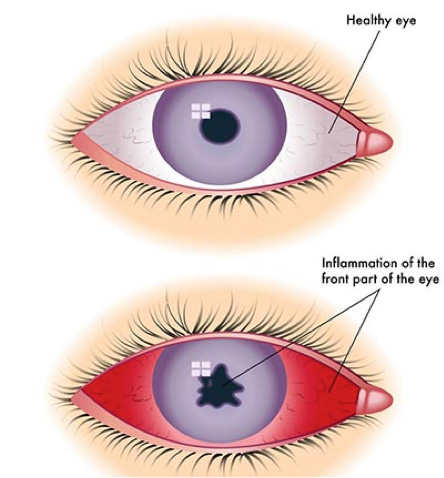
What is Uveitis?
Uveitis is a general term describing a group of inflammatory diseases that produces swelling and destroys eye tissues. These diseases can slightly reduce vision or lead to severe vision loss.
The term “uveitis” is used because the diseases often affect a part of the eye called the uvea. Nevertheless, uveitis is not limited to the uvea. These diseases also affect the lens, retina, optic nerve, and vitreous, producing reduced vision or blindness.
Uveitis may be caused by problems or diseases occurring in the eye or it can be part of an inflammatory disease affecting other parts of the body. It can happen at all ages and primarily affects people between 20 to 60 years old. Uveitis can last for a short (acute) or a long (chronic) time. The severest forms of uveitis reoccur many times.
What Causes Uveitis?
Uveitis is caused by inflammatory responses inside the eye.
Inflammation is the body’s natural response to tissue damage, germs, or toxins. It produces swelling, redness, heat, and destroys tissues as certain white blood cells rush to the affected part of the body to contain or eliminate the insult.
Uveitis may be caused by:
• An attack from the body’s own immune system (autoimmunity).
• Infections or tumors occurring within the eye or in other parts of the body.
• Bruises to the eye.
• Toxins that may penetrate the eye.
The disease will cause symptoms, such as decreased vision, pain, light sensitivity, and increased floaters. In many cases the cause is unknown. Uveitis is usually classified by where it occurs in the eye.
Diseases Associated with Uveitis:
- AIDS
- Ankylosing spondylitis
- Behcet’s syndrome
- CMV retinitis
- Herpes zoster infection
- Histoplasmosis
- Kawasaki disease
- Multiple sclerosis
- Psoriasis
- Reactive arthritis
- Rheumatoid arthritis
- Sarcoidosis
- Syphilis
- Toxoplasmosis
- Tuberculosis
- Ulcerative colitis
- Vogt Koyanagi Harada’s disease
An eye care professional will usually prescribe steroidal anti-inflammatory medication that can be taken as eye drops, swallowed as a pill, injected around or into the eye, infused into the blood intravenously, or, released into the eye via a capsule that is surgically implanted inside the eye. Long-term steroid use may produce side effects such as stomach ulcers, osteoporosis (bone thinning), diabetes, cataracts, glaucoma, cardiovascular disease, weight gain, fluid retention, and Cushing’s syndrome. Usually other agents are started if it appears that patients need moderate or high doses of oral steroids for more than 3 months.
